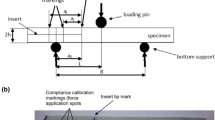Abstract
The objective of this work was to analyse and understand the types of fracture surface morphology found in unfilled and particulate-filled epoxy resins in the light of the thermomechanical history of the specimen (loading rate or duration of loading, temperature, strain at break). Short-term tensile tests and long-term creep tests were conducted at four different temperatures. The fracture surface features were analysed using the scanning electron and optical microscopes and, where suitable, an image analyser. In order to correlate these morphologies with certain regimes of crack velocity, fracture mechanics tests were also conducted, varying the crack speed between 10−7 and 102 m sec−1. In the case of the filled resin, the lifetime under static loading is governed by a phase of slow, sub-critical crack growth which is manifested by resin-particle debonding. Thereafter, the crack accelerates and finally may reach terminal velocities depending on the amount of stored elastic energy available at the moment of fracture.
Similar content being viewed by others
References
B. Rosen (ed.), “Fracture Processes in Polymeric Solids: Phenomena and Theory” (Interscience, New York, 1964).
B. W. Cherry andK. W. Thomson,J. Mater. Sci. 16 (1981) 1925.
M. J. Owen andR. G. ROSE,ibid. 10 (1975) 1711.
B. E. Nelson andD. T. Turner,Polym. Lett. 9 (1971) 677.
C. B. Bucknall, “Toughened Plastics” (Applied Science, London, 1977).
B. Stalder, Ph. Béguelin andH. H. Kausch,Int. J. Fracture 22 (1983) R47.
A. C. Moloney, H. H. Kausch, T. Kaiser andH-R. Beer,J. Mater. Sci. 22 (1987) 381.
R. J. Morgan andJ. E. O'Neal,ibid. 12 (1977) 1966.
M. Glad, PhD thesis, Cornell University (1986).
J. W. Smith, T. Kaiser andA. C. Roulin-Moloney,J. Mater. Sci., submitted.
H-R. Beer, T. Kaiser, A. C. Moloney andH. H. Kausch,J. Mater. Sci. 21 (1986) 3661.
H. Schardin, in “Fracture”, edited by B. L. Averbach, D. K. Felbeck, G. T. Hahn and D. A. Thomas (Wiley, New York, 1959) p. 297.
J. P. Dempsey andP. Burgers,Int. J. Fracture 27 (1985) 203.
Z. T. Bieniawski,ibid. 4 (1968) 415.
E. H. Yoffe,Phil. Mag. 42 (1951) 739.
K. Ravi-Chandar andW. G. Knauss,Int. J. Fracture 26 (1984) 141.
J. W. Johnson andD. G. Holloway,Phil. Mag. 14 (1966) 731.
G. K. Bansal,ibid. 35 (1977) 935.
J. D. Eshelby, in “Inelastic Behaviour of Solids”, edited by M. F. Kanninen, W. Alder, A. Rosenfield and R. Jaffe (McGraw-Hill, New York, 1970) p. 111.
Author information
Authors and Affiliations
Rights and permissions
About this article
Cite this article
Cantwell, W.J., Roulin-Moloney, A.C. & Kaiser, T. Fractography of unfilled and particulate-filled epoxy resins. J Mater Sci 23, 1615–1631 (1988). https://doi.org/10.1007/BF01115700
Received:
Accepted:
Issue Date:
DOI: https://doi.org/10.1007/BF01115700



